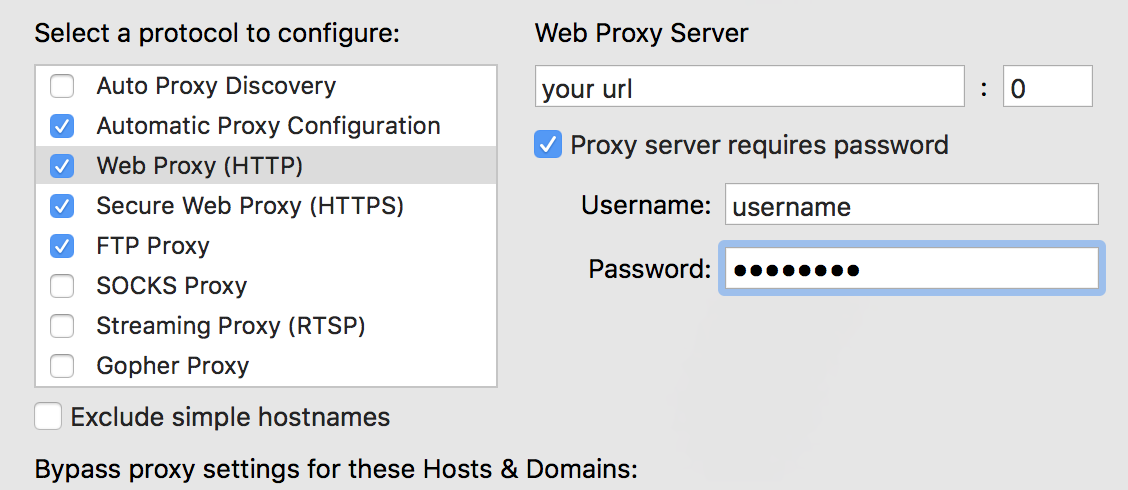If you select Automatic Proxy Configuration, enter the address of the PAC file in the URL field. Check with your network administrator if you need more information. If you configure your proxy settings manually, do the following: Select a proxy server, such as FTP Proxy, then type its address and port number in the fields on the right. To configure Manual Proxy mode on Mac OS X: Enable the PGP Desktop manual proxy option: Click Preferences - Messaging - and then click the Proxy Options button. Then select Manual Proxy using IP: 127.0.0.1 and click OK. Open PGP Desktop select PGP Messaging. Delete the PGP Messaging service that is not working correctly.
- Manual Proxy Settings
- Manual Proxy Setup Address
- Configure Manual Proxy Mac Download
- Manual Proxy Configuration
- How To Configure Proxy Settings
If your computer is connected to a local network that’s protected from the Internet by a firewall, you may need to specify proxy servers or use the FTP passive mode (PASV) to access some Internet sites. A proxy server is a computer on a local network that acts as an intermediary between a single computer user and the Internet, so that the network can ensure security, administrative control and caching service.
How to Disable Proxy Settings. This wikiHow teaches you how to remove the proxy server settings from Safari and Chrome on your PC or Mac. Open Chrome on your Mac. You'll usually find it in the Applications folder. Setup Charles Proxy on Mac. 2 Download and Install. 3 Uncheck Mac OS X Proxy. 4 Setup External Proxy. 5 Proxy Settings. 6 Configure CLI 6.1 Option 1 (Always set) 6.2 Option 2 (Turn settings on and off). Windows - Click LAN settings, then edit the URL in the Address section and/or change the port used to connect in the Port section. Mac - Select the proxy you want to edit on the left side of the page, then change the URL in the Address field, the username and/or password in the Username and Password fields, and the bypassed sites in the Bypass field.

On your Mac, choose Apple menu > System Preferences, then click Network.
Select the network service you use in the list — for example, Ethernet or Wi-Fi.
Click Advanced, then click Proxies.
If you configure your proxy server settings automatically, select Auto Proxy Discovery to automatically discover proxy servers, or select Automatic Proxy Configuration if you’re using a proxy auto-configuration (PAC) file. If you select Automatic Proxy Configuration, enter the address of the PAC file in the URL field. Check with your network administrator if you need more information.
If you configure your proxy settings manually, do the following:
Select a proxy server, such as FTP Proxy, then type its address and port number in the fields on the right.
Select the “Proxy server requires password” tickbox if the proxy server is protected by a password. Enter your account name and password in the Username and Password fields.
You can also choose to bypass proxy settings for specific computers on the Internet (hosts) and segments of the Internet (domains) by adding the address of the host or domain in the “Bypass proxy settings for these Hosts & Domains” field. This might be useful if you want to make sure you’re receiving information directly from the host or domain and not information that’s cached on the proxy server.
Manual Proxy Settings
To bypass a single domain, enter the domain name — for example, apple.com.
Manual Proxy Setup Address
To bypass all websites on a domain, use an asterisk before the domain name — for example, *apple.com.
To bypass a specific part of a domain, specify each part — for example, store.apple.com.
iOS has a feature that allows you to set up a proxy so that all the network requests from your device are forwarded to a proxy server. This is usually used on business and school networks and can also be used for hiding your IP address or accessing websites that are blocked in your region.
Configure Manual Proxy Mac Download

Configuring a proxy server on your iPhone is quite simple. All you need is the credential details of the proxy server, which will then be used to set up the proxy on your device. Here’s how you can configure and use a proxy server on your iPhone, iPad or iPod.

How to Configure and Use Proxy on iPhone or iPad
Step 1: Open the Settings app and go to WiFi.
Step 2: Tap the name of the WiFi network you’re connected to.
Step 3: Scroll to the bottom and you’ll find a section for HTTP Proxy. This is set to Off by default. You can either set it to ‘Auto’ for automatic proxy detection or ‘Manual’ for manually configuring the proxy settings.
- If you select ‘Auto’, a new field is shown for URL. Enter the address of the proxy auto-configuration script into the URL field.
- If you have the proxy server’s address and port, then choose ‘Manual’ and continue with the steps below.
Step 5: Enter the address of the proxy server into the ‘Server’ field and then enter the port number.
Manual Proxy Configuration
Step 6: If the server requires a username and password, turn on the Authentication toggle and enter the necessary details.
Step 7: Once you’ve entered all the details correctly, your device will now forward all the network requests to the configured proxy server. If you can access websites or the internet without getting any errors, it means that the proxy configuration is correct.
That’s all you need to do to configure and use a proxy on your iPhone or iPad. If you are unable to access the internet after enabling proxy, it means that the proxy credentials are incorrect or that the proxy server has issues.